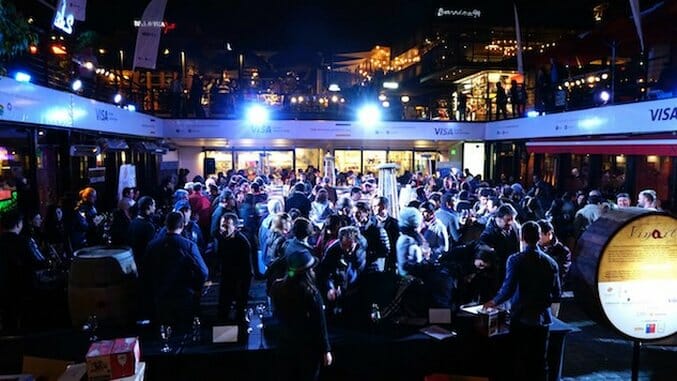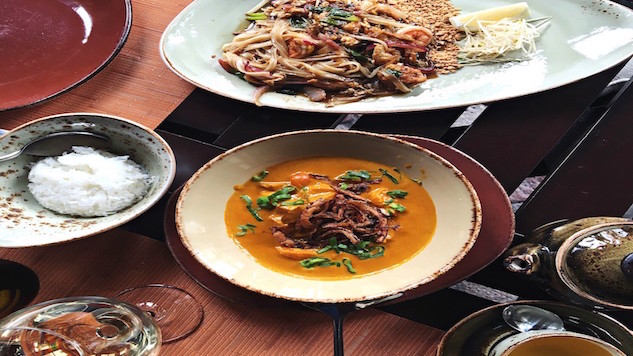
A unique blend of chic cosmopolitan style and rugged outdoor adventure, the city of Santiago, Chile is as multifaceted as the people who call it home. Towering skyscrapers are flanked by snow-capped mountain peaks and bustling nightclubs are nestled beneath swaying palm trees. The charm lies in the balance—the perfect marriage of nature and urban sprawl. Despite being the capital, Santiago doesn’t see a whole lot of tourists—and you’d be hard pressed to find more than a few handfuls who speak understandable English.
It’s a city deeply rooted in its heritage and history, and to understand and see it, you almost need to speak the language or have a guide. It’s a place built for strolling for hours without care through the glamorous barrio of Bellavista to the bustling La Vega Market.
Thanks to the lack of tourists, you can easily get off the beaten path—even in the center of the city.
So, whether you’re staying for a day or a week, get lost in Chile’s capital by sinking your teeth into the mouthwatering food scene and the magnificent culture.
1. San Cristóbal Hill

With over 1784 acres of lush green space and epic panoramic vistas of the sprawling city, it’s easy to spend a few hours getting lost in the views from the top of San Cristóbal Hill. Although you can take a funicular up to the top, the best way to tackle this hill is with a hike up the switchback dirt trail. The climb takes about 45 minutes up and 30 minutes down (you can skip the walk down for the funicular if you’re beat). In addition to lush gardens and steep vantage points, along the way you’ll also find a 46-foot statue of the Virgen de la Inmaculada Concepción Tower at the summit, terraced benches for seating, the National Zoo, the municipal garden and the Plaza de Juegos Infantiles Garbiela Mistral (a children’s park with an interactive fountain) and two swimming pools.
2. La Vega Market
The heart of any South American city lies in its food markets, and La Vega in Santiago is no exception. You can feel the pulse of the city as you stroll through the tight, narrow corridors, past rows of fresh fruits and vegetables piled sky high, pig heads glaring from butcher shops and locals selling fresh made pan amasado (soft, fluffy rolls). It’s dirty, chaotic and overwhelming, but it’s where you’ll find most of the locals clustered on weekends. For an authentic experience, go on a Saturday and get lost in the momentum. If you’d prefer a less costive experience, go in the morning when most of the vendors are still setting up.
3. Plaza de Armas
The epicenter of Santiago, Plaza de Armas is at the heart of the colonial city. Surrounded by 19th century government buildings, towering statues and a palm-tree lined park, this historical center (which translates to the Square of Weapons) dates back to colonial
times. The city is steeped in history, but there’s plenty here to occupy your time, like exploring the neo-classical Catedral Metropolitana, whose Baroque interior provides a stark contrast to the European exterior.
4. Local Food

Chile may not be known the world over for its gastronomy, but a few bites in Santiago might very well change your mind. More than just beef and red wine (although both are good bets), the city is home to an incredible variety of Latin and South American inspired cuisine. Start your forage with a completo, a hearty frankfurter topped with avocado, tomatoes, onions and spicy pepper sauce or mayonnaise. If you’re starving, nosh on a pastel de chocio (a blue collar meal made from meat, vegetables and cornmeal) and wash it down with a Coca Cola. Santiago is known for its seafood, thanks to Santiago’s proximity to the coast (just one hour), so you’ll find dishes like Zarzuela de Mariscos (seafood stew), Piernas de Cangrejo (crab legs) and piping hot seafood empanadas at almost every restaurant or market vendor. To look at the catch of the day (and grab seafood from the source), head to Mercado Central, the large fish market in the center of town home to fish stalls and restaurants.
5. La Piojera

From the outside, La Piojera, which sits on Aillavilú avenue, looks simply like a sketchy hole in the wall, a place you’d probably avoid if you were traveling alone. Truth be told? The inside isn’t much better, but as soon as you step through the doors you’ll be met with the howling sounds of laughter from the tiny main room, which is almost always packed with locals (regardless of the time of day). The bar is dingy and the murals on the walls are faded, however, you won’t find a better testament to Santiago culture. Plus, it’s home to one of the city’s most prized cocktails—the Terremoto, aka the Earthquake. Sweeter than syrup, this drink is made from a saccharine herbal spirit, grenadine, bitters and a hefty serving of pineapple ice-cream. Called the earthquake for a reason, a few of these will leave you shaking.
6. Bellavista
By day, Bellavista (pictured at top) looks and feels like Brooklyn—brightly painted street art covers buildings, ski-cap clad bearded locals sip coffee al fresco in neighboring cafes, and students buzz in and out of the artisan clothing and home shops. However, at night the neighborhood transforms into one of Santiago’s liveliest. By nightfall, the main drag, Pio Nono, is filled with locals wandering in and out of the music-bumping, neon-lit dance clubs, sloppily chugging pisco and cokes. More than just nightclubs, though, the area is also populated with some of Santiago’s most expensive restaurants, like Anakena in the Grand Hyatt and Aqui Esta Coco. If you’re interested in more of a cultural night out, hit one of the barrio’s many salsa clubs for a look at one of South America’s most famous dances.
7. Wine Tasting
Even though you don’t have to venture far in Santiago to sample some of Chile’s famous wines, you’d be remiss not to head out of the city for a day of wine tasting. Within easy reach of some of the country’s oldest wineries, the city offers tours to taste the hearty reds Chile is known for. Start with the Maipo region, which is surrounded by rolling green vineyards and snow capped mountain peaks, home to Vina Concha y Toro, Vina Cousiño Macul and Vina Undurraga, three of the area’s premier wineries. Aside from tasting famous and robust wines, you can even watch the farmers pluck, sort and harvest the grapes in early March. It’s recommended you make reservations at least 24 hours ahead of time and it’s best to go with a guide. That way, you can learn all about the wines as you sip them, and get deeper insight into the rich wine heritage of the country.
Claire Gallam is a seasoned writer and photographer with a passion for food and travel. She has spent time in more than 40 countries and hundreds of cities.